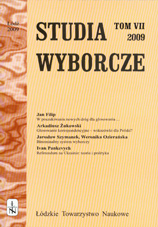W poszukiwaniu nowych dróg dla głosowania i ich wpływ na aktywność wyborców
Searching for new ways of voting and their influence on the voters activity
Author(s): Jan FilipSubject(s): Politics / Political Sciences
Published by: Łódzkie Towarzystwo Naukowe
Summary/Abstract: Decreasing voter turnout regularly evokes discussions on its causes. Except basic questions, as are an aversion to politics, politicians and political parties in general and to concrete parties and politicians in particular, sometimes attention is turned also to the technical solutions (so-called alternative voting). They are considered as a way, how voter turnout would be increased as in objective terms, so in subjective ones. Below first standpoint I can understand situation (No. 1), when voter is ready to take part in voting, but detachedly cannot (employment, hospital treatment, stay abroad, execution of an jail punishment etc.). Under second standpoint it is necessary comprehend situation (No. 2), when though voter can take part in elections, however he or she is refusing to do so. In terms of constitutional regulation of elections and the very electoral process it is possible tackle the situation No. 1. The article deals with techniques, that may it ensure. It is necessary to distinguish the forms of voting according the form of voters’ participation. Firstly it is an electoral assembly, where voters are gathering in one place and in the same time (as a rule to the end 19. century). Further it is presentation voting (on the basis of voter rolls). In such a case, the respective election territory is already divided in electoral wards and voters vote after their presentation by the electoral officers in polling stations during the time prescribed. Development in the field of election law trends to distant forms of voting (remote voting). As techniques are here offered: a) proxy – voting (voting by substitute), b) voting in advance (called “early voting” in the USA), c) voting with the help of electoral certificate (vote pass) in the polling station according the situation of voter, d) voting with the help of the portable ballot box, e) establishment of special electoral wards (e.g. in abroad), f) voting in abroad, g) s.c. e-voting (by mail, internet), h) mail voting by letter, i) holding more election in the same time etc. Particular forms of alternative voting occur side-by-side or beside the classical ballot, they may however gradually set aside the traditional ballot (see e.g. Oregon since 1998 or universal postal referendum in New Zealand in 1997).
Journal: Studia Wyborcze
- Issue Year: 2009
- Issue No: 07
- Page Range: 7-24
- Page Count: 18
- Language: Polish

